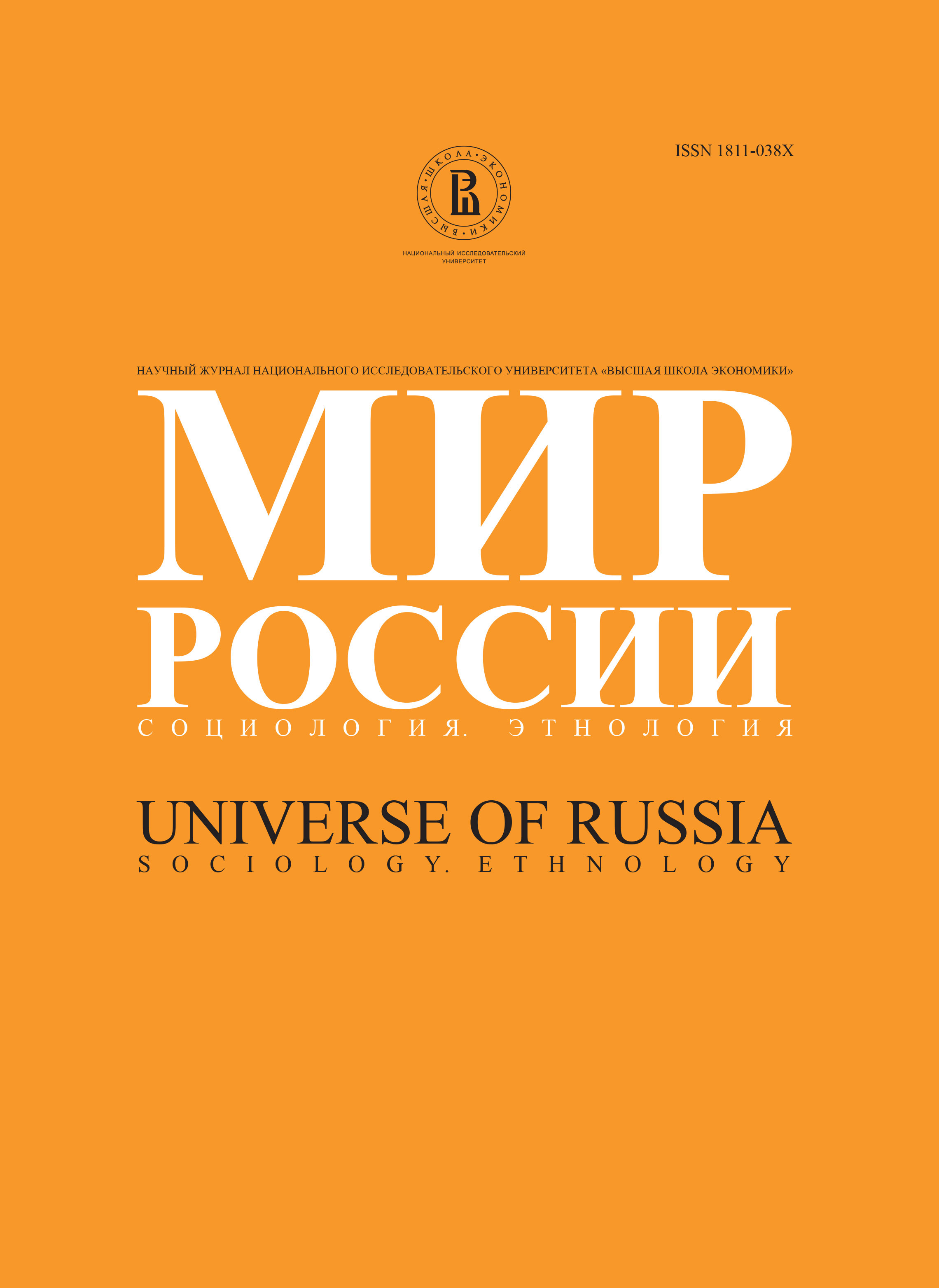Социоэкономика как наука и новая учебная дисциплина
Аннотация
In this paper socioeconomics is regarded both as an interdisciplinary paradigm developed by SASE (International Society for the Advancement of Socio-Economics) and economic science which should solve a number of practical tasks dealing with the economic assessment of bilateral bonds between economy and society (under social context). Further socioeconomics is also discussed as a new discipline for Russian universities which includes both versions of socioeconomics (advanced interdisciplinary and economic). The experience of its integration in learning process is analyzed and the concept and program of the learning course in State University – Higher School of Economics are put forward. Supporting the importance of developing socioeconomics as an interdisciplinary paradigm the author aims to show, that the SASE-version of socioeconomics does not use up its full interpreting potential. It can be substantially extended with the use of “particular” sciences within interdisciplinary paradigm and developing another version of socioeconomics as an economic science. This version aims at solving practical tasks inherent in advanced stable socio-economic systems as well as in many of the transforming economies and societies.The basics of socioeconomics as an interdisciplinary paradigm are well described by the well-known “minimum-platform” SASE (1991) and have been recently made more precise by its author A. Etzioni (2003). While this paradigm is still under development and being discussed by scientific association (Piore, Wrong, Streeck, Hollingsworth, Abell, Swedberg), the author also identifies those features of the socioeconomic paradigm of SASE, which reduce its expository and predicting power but have not yet become subject to discussions:
1. Reverse influence of economic values on the non-economic ones is not taken into account (the dependent value is always an economic one), which reduces the possibility of learning real interactions and patterns of economic and social development within different levels of social reality – macro-, meso- and micro.
2. The range of independent variables gradually shortens due to the exclusion (more often a forced one) of economic variables. Presently it is accepted, that a dependent variable is an economic one, while all of the independent variables are non-economic. No doubt, that to emphasize, that there should be at least one non-economic variable among the independent ones, is somewhat unconvincing. Basically it is correct to retreat from such claims, because interdisciplinary approach underlies its methodological principles. But it is as well unconvincing to reduce the independent variables to purely non-economic ones.
3. The socioeconomic paradigm of SASE fairly signifies moral obligations, social expectations and power relations which influence the behavior of economic actors. A lot is said about the role of morality and collectivity (“we”), density of social bonds between individuals, group norms on individual behavior. It is not often, but mentioned that the state and big corporations have a greater (with respect to other market participants) influence on economic behavior of the ordinary actors. Meanwhile it is necessary to accentuate, that different economic actors differ not only by their value orientations, but also by the scale and structure of the resources they possess. As far as individual actions are multisided the individual’s behavior is influenced not only by economic or cultural and professional resources, but other different resources: political, managerial, power, social (including status), etc. The level of the individuals’ social status defines the scales of both their constructive and destructive influence on the functioning of the economic system. We can compare, for example, the pilfering of the people which lie at the lowest level of social hierarchy (as a means for their physical survival) and the financial fraud of the higher state officers (as a means for their personal enrichment at the cost of the rest of society). The resource potential differs significantly between rural residents and capital citizens, residents of labor-abundant and labor-lacking regions, men and women, young and old, well-educated and low-educated, etc.
Thus today socioeconomics of SASE doesn’t use up the potential of “particular” sciences. Their integration under SASE usually applies within economic sociology and economic psychology. The weaker role of other sciences doesn’t allow us to use the full potential of the interdisciplinary approach. And even, perhaps, economics belongs to that list, though theorists of SASE call upon its further integration with social sciences. The author stresses her attention on the negative outcomes of the economists unwillingness to integrate with SASE. One of the most important extensions of socioeconomic paradigm of SASE (and by no means the only one) is to develop its new version – socioeconomics as an economic science. Its development can become that very “bridge” which would facilitate the integration of economic science into interdisciplinary version of the SASE-socioeconomics. But what is it exactly, this version of socioeconomics?
Under the constant meshing of social and economic life, acceleration of changes, increasing losses from unconsidered interactions between social and economic aspects of the functioning of macro-, meso- and microsystem (both, social and economic) there emerges a greater necessity in a special science which could assess the interaction between the economy and the society (social context) in terms of measuring and comparing costs and outcomes. Socioeconomics (in its economic version) studies bilateral bonds between economic and social aspects of social reproduction at different levels of social reality (macro-, meso- and micro) and attempts to assess these bonds economically through comparing widely understood costs and outcomes under definite social constraints.
The fact, that a wide range of social phenomena, institutions and processes greatly influences the economy, is a major thesis of SASE-socioeconomics. But with such application its influence has no economic assessment (in perfection, a monetary one), i. e. it is not considered in terms of gains and losses of economic actors and systems at different levels. Economic version of socioeconomics extends the approach of SASE in studying the influence of the social context on the economy (it is primarily a contribution of economic sociology and economic psychology) with economic assessment of this influence. What are, for example, economic losses from growing alcoholism and drug addiction among the youth in rural towns and villages? Where, say, economic sociology ends with uncovering of dominating strategies of saving behavior, its factors and restrictions, socioeconomics would use it only as a foundation for further research attempting to measure its economic gains/losses (of banks, individuals, economic system as a whole).
Another major distinction of the proposed version of socioeconomics from its SASE-version is the idea that it has to study reverse effects from the economy’s influence on the society and provide it, again, with economic assessment. In other words, economic version of socioeconomics proceeds from the assumption, that social domain (as an entity of social relations and institutions) as well as other social processes do not only influence the economy, but are also “submerged” in it, depend on it. No doubt, every human life is priceless. But with financing public health under 3% of GDP it becomes necessary to anticipate the economic loss, to which such “saving” would bring in future.
The author also shows that in developing the economic version of socioeconomics in modern Russia there is a clear practical necessity. It can facilitate the search for more effective solutions to a wide range of practical problems, which are faced by the actors at different levels. In particular, the important analytical and expert part of socioeconomics in modern Russia lies in complex valuation of consequences of introduction of chargeable services in a number of public branches, as well as in measuring the effectiveness of government expenditure on free public services. At firms’ level there also emerges a number of tasks: measuring the effectiveness of human capital investment, intangible assets, different elements of the intellectual capital (human, structural, market (goodwill, consumer relations, insiders, etc.)). Without thorough assessment of such close interconnection between economic and social aspects it is barely possible to avoid unfavorable consequences at most of levels of social reality.






